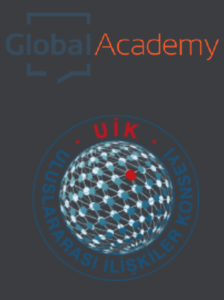- E-ISSN: 2718-0549
- DOI: 10.13140/RG.2.2.34620.36480

Abstract
With the protracted situation of Syrians, refugee livelihood emerged as an important policy area in Turkey, with its significant impact on younger generation. We believe that vocational and technical training on energy technologies and systems exhibits a livelihood potential not only for the local, but also for the Syrian youth. We explored this idea during the course of the project titled Next Generation (NEXT-GEN hereafter), carried out by the Center for Energy, Environment and Economy (CEEE) at Özyeğin University. We argue, while livelihood is fundamental during Syrians’ stay in Turkey, attainment of knowledge and training on energy also retain a capability for the future of region at large –including Syria– either upon their prospective return, or within their already observed emerging transnational ties, as energy is a globally tackled issue, which is timeless.
Introduction
The NEXT-GEN project aimed at contributing the formation of a solid culture on energy efficiency education, carrying on the experience and knowhow gained by the CEEE researchers to Southeast Turkey. Funded by the Islamic Development Bank (IsDB), and in collaboration with the Republic of Turkey Ministry of National Education (MoNE) and the Ministry of Energy (MoE), the project started off with the vision of training the local energy efficiency leaders of the future. The reason of selection of South East Turkey was to make a field test at the school buildings, due to the climatic resemblance of the region with İstanbul, according to the presently referred Turkish standards for insulation calculations, TSE 825 and due to the high unemployment rates in the region, housing most of the incoming refugees. The project had three main objectives of generating energy efficiency literacy, infrastructure, and impact. While the first objective focused on raising awareness on low energy buildings, targeting a large range of citizens from different age groups and different professional backgrounds, the second goal, energy efficiency infrastructure, stipulated a detailed studying and monitoring of energy performance of ten public educational buildings in Southeast Turkey. The third objective, impact, was envisioned on three, i.e., macro-, meso-, and micro-levels.
On a macro-level, an anergy audit was conducted and energy efficiency guidelines were prepared to set the standards and parameters of zoning legislation and to upgrade daily construction habits in the ten pilot cities chosen in Southeast Region of Turkey. The collected data during the project were analyzed to develop a road map for renovation of public buildings, especially schools. The ten cities chosen in the region were Adıyaman, Batman, Diyarbakır, Gaziantep, Kahramanmaraş, Kilis, Mardin, Siirt, Şanlıurfa and Şırnak. During the energy audits, students were selected by the school management, who were interested in energy efficiency related subjects and who would be thinking of taking steps towards energy efficiency leadership in their cities. Accordingly, an Energy Efficiency Catalogue was prepared for the use of the ten pilot municipalities.
On a meso-level, the project was carried out in ten pilot vocational and technical schools selected jointly with the MoNE. Supported by AI based Chat-Bot, and face-to-face trainings, those teachers practicing energy related subjects in these schools were instructed on the developments in the energy efficiency and renewable energy fields with the aim of transferring their extended knowledge to their students. This tutor-pupil transmission of knowhow and information on a subject that is not widely studied in the region was an important component of the project for two reasons: First, in a region where unemployment rates are the highest in the country, energy efficiency has the potential for creation of jobs, especially given the regulatory changes based on the Energy Efficiency Law. The ten cities chosen for the project have the highest unemployment rates with 27 percent unemployment and 28 percent employment in 2017. In order to understand the potential of employment in energy sector for the region, the following numbers are quite important: while there are 5988 certified energy managers in Turkey, there are only nineteen in Adıyaman, thirteen in Batman, twenty-seven in Diyarbakır, seventy-eight in Gaziantep, thirty-two in Kahramanmaraş, four in Kilis, eight in Mardin, seven in Siirt, eleven in Şanlıurfa, and six in Şırnak (a total of 185 out of 5988, or just 3.1%). It is indicated at the website of the Directorate of Renewable Energy at the Ministry of Energy that among the forty-four energy audit companies, only one is located in Southeast Turkey, in Gaziantep, thus, confirming the prospective employment chances in the region.
Second, the region is hosting a large Syrian community who are registered under a temporary protection regime in Turkey. A large proportion of this population is composed of youngsters at school age presenting a cohort of potential students in the system. Official numbers of the Directorate General of Migration Management under the Ministry of Interior indicate that the ten cities incorporated in the project have been hosting more than one million Syrians. Today, most of the children and youngsters are bilingual, speaking Arabic and Turkish, and there are official programs for their adaptation in Turkish education curriculum. Syrians’ extended duration of stay in the country has brought about refugee livelihood as an important policy area. Thus, vocational and technical training on energy exhibits a livelihood potential also for the youth of this community. While livelihood is vital during their stay in Turkey, gaining of such knowledge and training on energy also retain a capability for the future of region at large –including Syria– either upon their prospective return, or within their already observed emerging transnational ties.
Thus, on a micro-level, the project also aimed to have an impact on social cohesion in the region with the assumption that there would be a number of Syrian students enrolled in the pilot schools chosen for the project. “Next generation” in this sense did not only refer to energy efficient buildings of the next generation, but also a cosmopolitan next generation where Syrian and Turkish students were working together. In this sense, NEXT-GEN was a transdisciplinary endeavor. Unfortunately, the impact of the project on this micro-level was rather dubious for different reasons: First, with the exception of Kilis, the selected schools by MoNE had almost no Syrian students. Second, due to the outbreak of Covid-19 during the project, our access to the field was very much constrained affecting the implementation of the planned activities negatively. Still, our limited encounters in the field featured important problems with regard to technical and vocational training, especially with regard to Syrian students and their social cohesion; thus, the focus of this policy brief.
An overview of Syrians in Turkey: Youth, Education, and Ten Pilot Cities
As of November 2020, there are more than 3,635,000 Syrian refugees registered under a temporary protection regime in Turkey. The number corresponds to almost four percent of the Turkish population. More than 45 percent of this populace is under age 18 (see Figure I), indicating the importance of education as a policy area under migration management. It is already known that children’s access to education is most disrupted during times of humanitarian crises. To illustrate, while the world average for primary and secondary school enrollment are 91 and 84 percent respectively, these ratios drop to 61 and 24 percent among refugee children (UNHCR 2019). These figures show that two thirds of refugee children cannot continue their education after primary school.
Figure I: Distribution by Age and Gender of Registered Syrian Refugees Recorded by Biometric Data
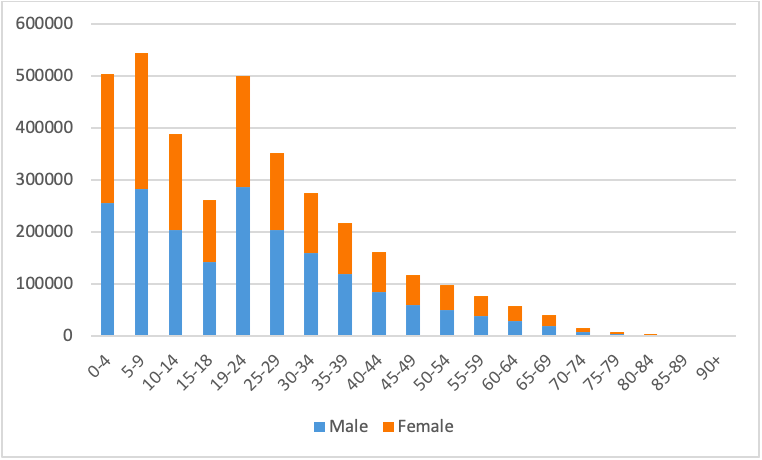
Source: Official Website of the Directorate General of Migration Management (Statistics based on November 2020 data).
In Turkey, 684,728 Syrian refugees were enrolled in formal education at the end of 2019; of these children, 96 percent were enrolled in Turkish public schools and open education, and almost four percent in Temporary Education Centers. Enrollment rates per level were 27 percent for pre-school, 89 percent for primary, 71 percent for lower secondary, and 33 percent for upper secondary levels. Still, approximately 37 percent of school-aged children remained out of school. Compared to 2018, the refugee university enrollment rate increased from three to six percent. Over the years, Turkey has been trying different policies and developing many projects to increase enrollment to prevent a lost generation. Before 2016, considering the stay of these children was mostly temporary, the country followed the German model, regulating the system via numerous circulars on an ad hoc basis. 2016 marked a year of change: with a circular of MoNE, it was made obligatory for Syrian children at the kindergarten and 1st grade levels to attend public schools, thus, explaining the increasing number of enrollments. Syrian children received fifteen hours of Turkish language lessons a week to be able to follow the school curriculum, which is fully Turkish as of 2017-2018 academic year –following an immersion model.
It is important to remember and underline that enrollment levels are not always very indicative unless conditions for continuous attendance are not provided (see for example different reports on child workers, especially seasonal agriculture workers, such as ERG 2018, Kalkınma Atölyesi Kooperatifi 2018, Hayata Destek 2014). Many children in Turkey, both local and migrant, have to work as child labor to help with the household income. It is also vital to note that the Covid-19 pandemic and the very fast transformation to online education increased the inequalities with regard to access to education for the already vulnerable populations.
It is within this context that NEXT-GEN project has considered technical and vocational training in an emerging sector such as energy as a livelihood opportunity not only for the local, but also the refugee students. As stated earlier, there were ten pilot cities chosen for the project. To give an overview of each city, as of October 2020, there were 22,125 Syrian refugees located in Adıyaman, which corresponded to 3.5 percent of the city’s population. Syrian refugees in Adıyaman were mostly enrolled in public schools. However, two youth centers were opened in the city to support their education. Youth centers offer Turkish language courses with the aim of supporting refugee children to enhance their ability to integrate in their local communities and in Turkish public schools. The programs are implemented in collaboration with Ministry of Youth and Sports. Adıyaman is also one of the cities to initiate a project to teach these refugee students Turkish. Also, recently, the Ministry of Youth and Sports developed a project to build social and sports facilities for refugees in multiple cities including Adıyaman. Similarly, there are 15,492 Syrian refugees located in Batman, which corresponds to 2.6 percent of the city’s population. There are two youth centers to support refugees’ education. Batman is also a part of the Ministry of Youth and Sports’ project to build social and sports facilities for refugees. In Diyarbakır, there are 23,237 Syrian refugees, which corresponds to 1.3 percent of the city’s population. There are six youth centers to support refugees’ education. Like the previous two cities, Diyarbakır is also a part of the Ministry of Youth and Sports’ project to build social and sports facilities for refugees. There are 451,510 Syrian refugees in Gaziantep, corresponding to 22 percent of the city’s population. There are three youth centers and five public education centers to assist refugees’ education. Public education centers provide accelerated learning programs that aim to support out of school refugee children to be able to access formal and non-formal education opportunities offered in close collaboration with the MoNE. Gaziantep is also one of the cities to initiate a project to teach these refugee students Turkish. Gaziantep is also a part of the Ministry of Youth and Sports’ project to build social and sports facilities for refugees.
In Kahramanmaraş, there are 92,554 Syrian refugees registered under the temporary protection regime, standing for eight percent of the city’s population. Again, there are two youth centers to support refugees’ education, and the city is also among the cities to initiate a project to teach these refugee students Turkish. Kahramanmaraş is also a part of the Ministry of Youth and Sports’ project to build social and sports facilities for refugees. In Kilis, there are 108,554 Syrian refugees, making up almost 76 percent of the city’s population. There is one youth and two public education centers to support refugees’ education. Like other cities in the project, Kilis is also one of the cities to initiate a project to teach these refugee students Turkish, and a part of the Ministry of Youth and Sports’ project to build social and sports facilities for refugees. In Mardin, there are 88,965 Syrian refugees, i.e., almost 11 percent of the city’s population. Mardin also hosts three youth centers to support refugees’ education and is a part of the Ministry of Youth and Sports’ project to build social and sports facilities for refugees.
The number of registered Syrians in Siirt is 4,376, making up 1.3 percent of the city’s population. Schools in Siirt are included in a “Project for the Integration of Syrian Students into the Turkish Education System” that offers Syrian students a weekly 15-hour intensive Turkish educational program aiming to facilitate integration into the Turkish education system. In Şanlıurfa, 421,543 Syrians are registered under the temporary protection regime, which corresponds to 20.3 percent of the city’s population. There are nine youth and nine public education centers to support refugees’ education. Şanlıurfa is also one of the cities to initiate a project to teach these refugee students Turkish, and a part of the Ministry of Youth and Sports’ project to build social and sports facilities for refugees. There are 415,001 Syrian refugees located in Şırnak, which corresponds to 2.8 percent of the city’s population. There are three youth centers to support refugees’ education.
It was within this context that we were expecting to meet many Syrian students during the implementation of the project in the pilot schools in the ten designated cities. As mentioned previously, with the exception of Kilis, the selected schools by MoNE had almost no Syrian students. This indicated that the Syrian students’ enrollment in the technical and vocational schools was very limited. The next section presents an overview of technical and vocational high schools in Turkey to identify the possibly underlying causes of this unforeseen result.
An overview of technical and vocational high schools in Turkey, and in ten pilot cities
Vocational and Technical Schools in Turkey have a strong tradition dating back to the 18th century (Aytaç 2006). These schools aim to prepare students suitable and necessary for the development of industry which ultimately allows for reducing unemployment rate among graduates (Bolat 2016). Today, total number of students enrolled in vocational and technical high schools is 35 percent of the total number of students in secondary education corresponding to more than a million students (MoNE 2018) (see Figure II). Given the high level of youth unemployment in Turkey, the overall ratio of students enrolled in vocational and technical high schools can be considered as rather low, emphasizing a venue for policy action.
Figure II: Student Enrollment Based on High School Type, Overall Turkey
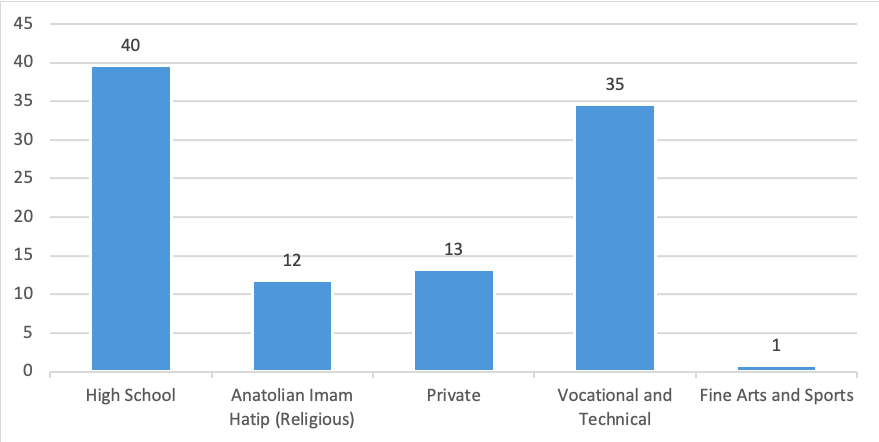
Source: The figure is from the online page http://meslekiegitimharitasi.meb.gov.tr/ and translated from the related caption on the main page ‘’Okul türüne göre öğrenci sayıları ‘’.
An outlook of vocational and technical education in Turkey based on number of educational institutions, teachers and students from 2008 to 2018 present an interesting finding: While the number of institutions decrease over the years from 4040 in 2008 to 3795 in 2018, the number of students increases from 1.3 to 1.5 million (see Figure III). Thus, the deficiency in vocational training in Turkey does not pertain only the refugees, but the country as a whole.
Figure III: Outlook of Vocational and Technical Education in Turkey, Number of Educational Institutions, Teachers, and Students (2008-2018)
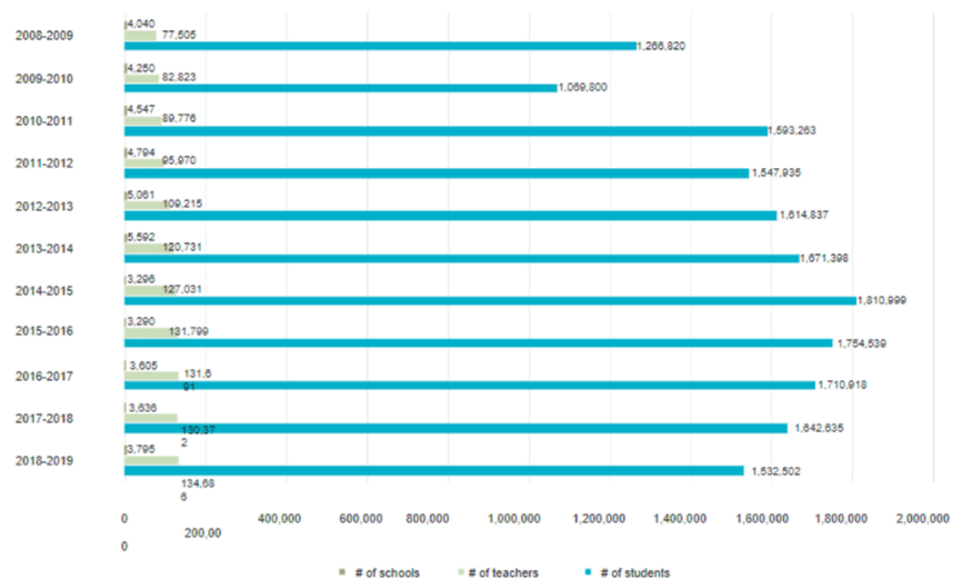
Source: Outlook of Vocational and Technical Education in Turkey, Series of Education Analysis and Assessment Reports, MoNE, 2018.
The male-female ratio studying in Vocational and Technical High Schools is 56.08 to 43.92 percent (see Figure IV). While the difference in the ratio might not seem very high, the enrollment in the fields and branches is very gendered. There are fifty-four fields and almost two hundred branches available in the vocational and technical schools. Occupational fields where the rate of male students is 90 percent or more are as follows: Metal Technology, Metallurgy, Installation Technology and Air Conditioning, Motor Vehicle Technology, Electrical-Electronics Technology, Aircraft Maintenance, Furniture and Interior Design, Shipbuilding, Machine Technology Industrial Automation Technologies, Rail Systems Technology, and Maritime and Agriculture. Yet, occupational fields where the rate of female students is 90 percent or more are as follows: Child Development and Education, Handicraft Technology, Family and Consumer Services, Patient and Elderly Services, Beauty and Hair Care Services, Clothing Manufacturing Technology, and Graphics and Photography. (MoNE, 2018).
Figure IV: Female and Male Students in Vocational and Technical High Schools, Overall Turkey
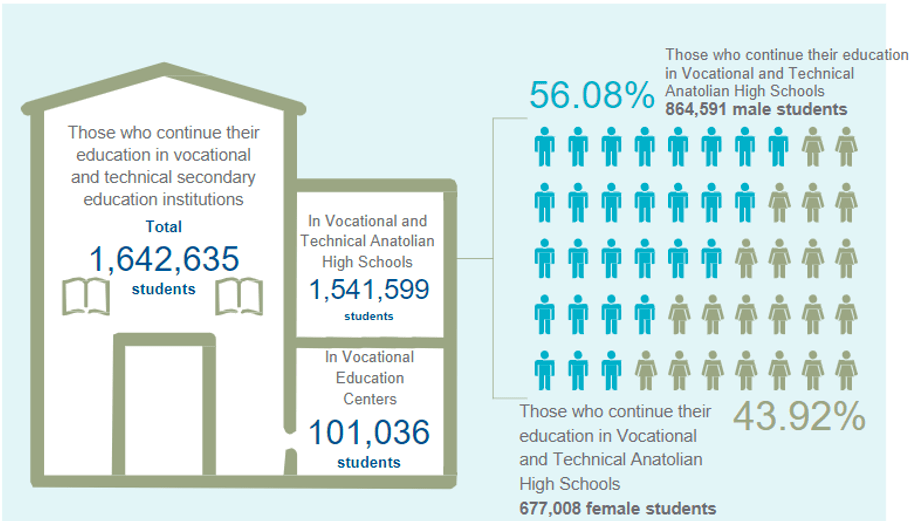
Source: Outlook of Vocational and Technical Education in Turkey, Series of Education Analysis and Assessment Reports, MoNE, 2018.
The number of foreign students enrolled in schools and institutions affiliated to the General Directorate of Vocational and Technical Education in the 2017/18 academic year is 8,173. While 68.8 percent is students from Syria, 16.9 percent is from Iraq and 14.3 percent is from Afghanistan. 67.9 percent of 8,173 students are studying in the 9th grade and 18.9 percent in the 10th grade. The distribution of these students to other education levels is as follows: Preschool education (1.2 percent), 11th grade (3.9 percent), 12th grade (1.8 percent), vocational education center (6.2 percent). It is important to note that all of the foreign students studying in vocational training centers are Syrians under temporary protection (Ministry of Development 2018).
The picture is rather different in the 10 NEXT-GEN provinces. With the exception of Kahramanmaraş, the ratio of students enrolled in vocational and technical high schools is lower than the overall ratio of Turkey, i.e., 35 percent (see Table I). The ratio of students undergoing vocational and technical high schools to all secondary education students in the pilot cities range from 19 to 35 percent. In almost all ten provinces, students enrolled in vocational and technical high schools seem to prefer information technologies and electrical electronics as their main subjects of study. Renewable energy technology field was included in the curriculum of only three pilot schools chosen for the project in Adıyaman, Gaziantep and Şanlıurfa.
Table I: Ratio of students attending in Vocational and Technical High Schools (to all secondary education students) in NEXT-GEN Provinces
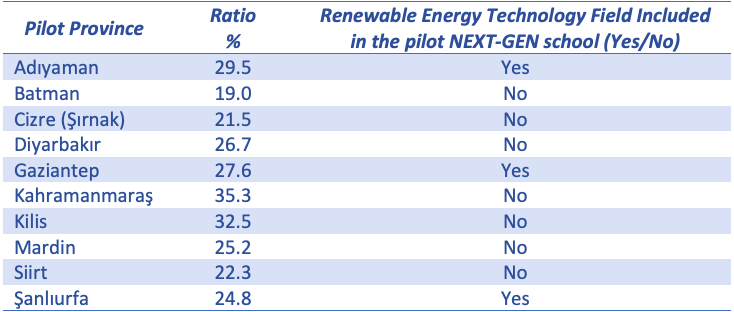
Source: Outlook of Vocational and Technical Education in Turkey, Series of Education Analysis and Assessment Reports, MoNE, 2018.
Observations and Suggestions for Future Research Directions
It is within this context that NEXT-GEN highlights the following observations and recommends proposals of action:
- Given the high level of youth unemployment in Turkey, it is of great importance to focus on sectors that have the potential of generating employment opportunities such as energy efficiency.
- Decreasing number of vocational and technical training institutions is alarming especially given the fact that the number of students in the country is increasing, including both locals and refugees.
- Policies and incentives must be developed to increase enrollment in vocational and technical schools, both of locals and Syrians especially in Southeast Turkey, where the registration levels are lower than the national average. The most recent example is the “Renewable Energy Sector Syrians and Host Employability Increasing for Community Members Project” funded by the Korean Government, UNDP Turkey and MoNE, at which Photovoltaic Solar Panels Installation and Hybrid (Solar-Wind) System Integration is thought in 40 hours to 500 people in five different cities, aiming to increase access to existing job opportunities in the energy sector. This sample should be adopted to vocational and technical schools.
- During the implementation of the NEXT-GEN, in those few schools where there were observable number of Syrian students, there were no specific integration policies employed by the teachers. So, it is crucial that teachers are trained not only on technical matters, but also on issues of social cohesion.
- While the overall figure of female students in vocational training is lower than males and the field choices are very gendered, the number is almost invisible among Syrian students –there was no female Syrian student in the schools visited for the NEXT-GEN project.
- Further policies must be developed to increase female student enrollment in STEM (Science, technology, engineering and mathematics) areas.
- Where applicable, Syrian students should be encouraged to choose renewable or traditional energy subfields –e.g., in provinces of Adıyaman, Gaziantep and Şanlıurfa to increase their potential for employment.
- Projects must be developed to analyze the effects of Covid-19 pandemic on the region (with highest unemployment rates), on education (increasing inequalities in terms of access to online education), on vulnerable groups (the poor, Syrians, and other migrants).
- The obvious problem caused by COVID-19 pandemic showed that although the digitalization of national education system is ready to provide adequate sources, the fact that the internet, computers, TV and Smart Phones are not easily accessible by students in the South Eastern region of Turkey, calls for a short-term solution which is the development of necessary infrastructure for online and distant learning capacity in the region.
- In order to cope with the recent and future problems caused by Climate Change, infrastructure for high tech technologies& implications should be developed as a mid-term goal.
- Technology Transfer Offices should be established for Syrian refugees in the long term to provide them job and inclusion in the economic development of country in the long term.
References
Aytaç, K. (2006). Çağdaş eğitim akımları (Yabancı ülkelerde). (1.Basım). Ankara: Mevsimsiz
Bolat, Y. (2016). Türkiye’de mesleki ve teknik eğitimin mevcut durumu ve farklı ülkelerle karşılaştırılması. Ankara: Pegem Akademi. https://doi.org/10.14527/9786053184409
Büyükikiz, K. K. & Çangal, Ö. (2016). Suriyeli Misafir Öğrencilere Türkçe Öğretimi Projesi Üzerine Bir Değerlendirme. Uluslararası Türkçe Edebiyat Kültür Eğitim Dergisi, 5(3): 1414-1430.
Daily Sabah (2020). “Turkey to build sports facilities for young Syrian refugees.” Accessed on 25 November 2020, at
Directorate General of Migration Management Official Website, https://www.goc.gov.tr/
ERG (2018), Eğitim Reformu Girişimi İzleme Raporu. Accessed on 25 November 2020 Available at
Hayata Destek (2014). Mevsimlik Gezici Tarım İşçiliği 2014 Araştırma Raporu. Accessed on 25 November 2020, Available at: https://www.hayatadestek.org/wp-content/uploads/2014/12/mevsimlik-gezici-tarim-isciligi-2014-arastirma-raporu.pdf
Higher Education Council Official Statistics, https://istatistik.yok.gov.tr/
Kalkınma Atölyesi Kooperatifi (2018). Yoksulun Umudu Çocuk: Mevsimlik Tarım İşçisi Hanelerin Sosyo-Ekonomik Profili ve Çocuk İşçiliği Araştırması. Accessed on 25 November 2020.
MoNE (2018). Türkiye’de Mesleki & Teknik Eğitim Görünüm Raporu. Accessed on 25 November 2020.
MoNE (2018) Outlook of Vocational and Technical Education in Turkey, Series of Education Analysis and Assessment Reports, Accessed on 30 November 2020
Republic of Turkey Ministry of Development Official Website, http://www.kalkinma.gov.tr/
Republic of Turkey Ministry of Energy and Natural Resources Official Website, https://www.enerji.gov.tr/
TUİK, Turkey Statistical Institute Official Website, https://www.tuik.gov.tr/
UNICEF Fact Sheet, Accessed on 25 November 2020.
UNHCR (2019), Report: Stepping Up Refugee Education.
Acknowledgements
This study was conducted with the support of the NEXT-GEN project led by the Center for Energy, Environment and Economy (CEEE/EÇEM) at Ozyegin University, Istanbul, Turkey. The project, which continued from December 2018 to February 2021, was supported by the Islamic Development Bank (IsDB) Transformers Fund. Deniz S. Sert was involved in the project as an expert. Yasemin Somuncu worked on the project during the proposal writing stage as well as the first year. Nil Kutlar contributed to the entire work. M. Pinar Mengüç and Dilek Saygı of CEEE/EÇEM were responsible for the overall execution of the project.
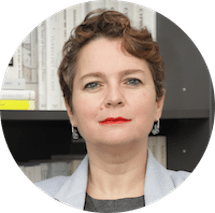
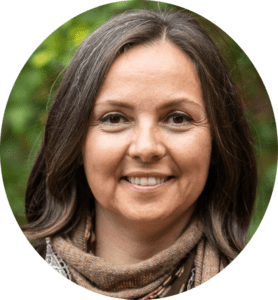
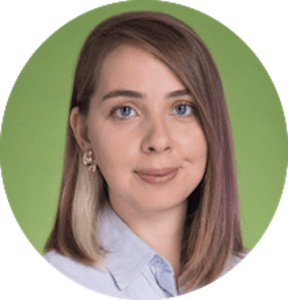
To cite this work: Deniz Ş. Sert, Yasemin Somuncu & Nil Kutlar, “A Debate on Vocational Training in Energy, Refugees and Livelihood”, Panorama, Online, 24 February 2021, https://www.uikpanorama.com/blog/2021/02/24/a-debate-on-vocational-training-in-energy-refugees-and-livelihood/
Copyright@UIKPanorama.All on-line and print rights reserved. Opinions expressed in this work belongs to the author(s) alone, and do not imply endorsement by the IRCT, the Editorial Board or the editors of the Panorama.


